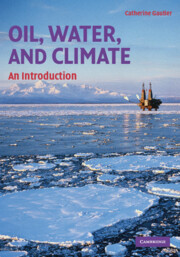Book contents
- Frontmatter
- Contents
- Foreword
- Introduction
- 1 Overview
- 2 Carbon Dioxide Emissions, Global Warming, and Water Resources
- 3 Population, Environmental Impacts, and Climate Change
- 4 Carbon Cycle and the Human Impact
- 5 Peak Oil, Energy, Water, and Climate
- 6 Oil Consumption and CO2 Emissions from Transportation
- 7 Oil, Economy, Power, and Conflicts
- 8 Energy Alternatives and Their Connection to Water and Climate
- 9 The Water Cycle and Global Warming
- 10 Fresh Water Availability, Sanitation Deficit, and Water Usage: Connection to Energy and Global Warming
- 11 Rivers, Lakes, Aquifers, and Dams: Relation to Energy and Climate
- 12 Water Contamination, Energy, and Climate
- 13 Geopolitics of Water and the International Situation
- 14 Water Alternatives
- 15 Global Climate Change: Observations, Modeling, and Predictions
- 16 Energy and Water Challenges and Solutions in a Changing Climate Framework: Commonality, Differences, and Connections
- References
- Index
11 - Rivers, Lakes, Aquifers, and Dams: Relation to Energy and Climate
Published online by Cambridge University Press: 05 September 2012
- Frontmatter
- Contents
- Foreword
- Introduction
- 1 Overview
- 2 Carbon Dioxide Emissions, Global Warming, and Water Resources
- 3 Population, Environmental Impacts, and Climate Change
- 4 Carbon Cycle and the Human Impact
- 5 Peak Oil, Energy, Water, and Climate
- 6 Oil Consumption and CO2 Emissions from Transportation
- 7 Oil, Economy, Power, and Conflicts
- 8 Energy Alternatives and Their Connection to Water and Climate
- 9 The Water Cycle and Global Warming
- 10 Fresh Water Availability, Sanitation Deficit, and Water Usage: Connection to Energy and Global Warming
- 11 Rivers, Lakes, Aquifers, and Dams: Relation to Energy and Climate
- 12 Water Contamination, Energy, and Climate
- 13 Geopolitics of Water and the International Situation
- 14 Water Alternatives
- 15 Global Climate Change: Observations, Modeling, and Predictions
- 16 Energy and Water Challenges and Solutions in a Changing Climate Framework: Commonality, Differences, and Connections
- References
- Index
Summary
The fresh water indispensable for life is stored in major river basins of the world and other forms of fresh water: lakes, reservoirs, and groundwater. Dams fragment rivers while regulating their flow and creating electricity. They may damage the environment and affect people in the surrounding areas. Dams have an effect on global warming, and global warming is expected to affect dams through predicted changes in the hydrological cycle, particularly precipitation.
Introduction
Earth provides a continually replenished supply of fresh water through a complex system of underground and surface fresh water storage and streams. The available surface fresh water in the world is found mainly in rivers, lakes, water reservoirs, and wetlands. The principal water reservoirs are artificial lakes formed by dams, whereas the wetlands are made up of swamps, marshes, lagoons, and floodplains. Large quantities of fresh water are stored underground in aquifers, sometimes for very long periods of time. Surface water and groundwater are not only essential for sustaining life on Earth but also play a crucial role in energy production and climate stability. Our daily lives and well-being depend on water resources much more than is often acknowledged.
Surface Water
Surface waters include lakes, reservoirs, rivers and streams, and wetlands that societies have depended on and benefited from throughout history. The flow into these water bodies comes from precipitation, runoff from melting snow, and ice and flow from groundwater systems.
- Type
- Chapter
- Information
- Oil, Water, and ClimateAn Introduction, pp. 205 - 221Publisher: Cambridge University PressPrint publication year: 2008



